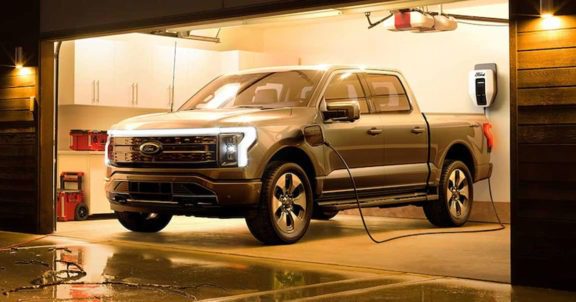Blog Post
Fleet Mobility Trends: EV Trucks, AV Group Rides
By Dan Belknap
March 3, 2020

With the start of the new decade, we’re poised to see many advancements in the mobility space. Here’s a list of a few upcoming trends likely to grow in prominence in the coming years. Note: Many of these items are limited launches and pilots of new technology to test efficiency and performance.
Battle of the EV Trucks
Tons of towing capacity, long ranges and zero emissions. Those are the metrics that a slew of automakers are touting in the race to create the next industry standard, all-electric truck.
Chevrolet Silverado is promoting its Fall 2021 EV with a 250 to 400-mile range and 12,000-pound towing capacity. Ford is teasing its F-Series electric pickup with a 450-mile range and up to 14,050 towing capacity.
The futuristic-looking Tesla CyberTruck claims of having better performance than a sports car yet with all the utility of a truck with more than 7,500 pounds of towing capacity and a 250-mile-plus range. Another recent EV announcement, the Nikola Badger electric pickup truck has 600 miles of blended fuel cell and battery energy range. Its towing capacity is 8,000.
A clear indication of a shift in the times is General Motors resurrecting the Hummer—expected to launch in 2022. Production of the vehicle halted in 2010 in response to both the recession and high fuel costs. The Hummer EV touts zero emissions, 1,000 horsepower and 0 to 60 in three seconds. Hummer is also planning a pickup truck with the debut slated for May 2020.
The fleet factor: These vehicles are proving that you don’t have to sacrifice distance or towing capacity in order to honor your corporate sustainability initiatives. This may be music to the ears of service fleets with admirable goals of having zero emissions by 2030. These vehicles would certainly fill the gap in the previous electric truck lineup.
Autonomous Group Rides
Autonomous vehicles (AV) may not be ready for single-person ownership yet but more and more automakers are piloting their self-driving fleets with the public for hailed and chartered rides. In late January, General Motors unveiled Origin in San Francisco. Without a steering wheel or brake pedals, up to four riders can summon the vehicle on the 24/7 Cruise app.
This announcement joins the many autonomous shuttles already in operation in many cities around the U.S. in limited routes such as business districts and university campuses. Visitors to the Detroit Auto Show in June can take an autonomous shuttle from the airport and the TCF center downtown.
Columbus, Ohio just announced the Linden LEAP, transporting people to and from the main transit center. The pilot is the nation’s first instance of an AV shuttle in a residential area. Here’s a list from Fleet Forward on where autonomous shuttles are gaining traction.
The fleet factor: A small sector of corporate fleets use buses to transport employees short distances, whether it be from a nearby transit station to headquarters or one corporate campus to another. An autonomous vehicle can easily take their place. And it’s a great way for companies to test the technology before making larger investments.
Connectivity Regulations & Smart City Moves
The ability of the connected infrastructure to thrive depends on the collaboration of many moving parts. Namely, regulatory bodies. There’s currently a conflict between congress and the Federal Communication Commission over opening the 5.9-gigahertz wireless communication spectrum to non-transportation use. This is the communication mode for certain vehicle-to-vehicle, -infrastructure and -pedestrian applications.
“The five-page letter – signed by House T&I Chairman Rep. Peter DeFazio, D-OR, Ranking Member Rep. Sam Graves, R-MO., and 36 committee members – strongly panned the FCC’s unanimously approved notice of proposed rulemaking that seeks to reallocate half of the 5.9 GHZ band due to the ‘slow deployment’ of dedicated short-range communications or DSRC technology, the emergence of new transportation and other communication systems, and escalating demand for unlicensed operations like Wi-Fi,” writes Sean Kilcarr of AASHTO, in Fleet Forward.
On the state front, the Georgia Department of Transportation issued a request for proposals for turnkey connectivity vehicle solutions for use in Metro Atlanta. This adds to the 400 locations in the area using the technology. Virginia is deploying its own inaugural instance of C-V2X. The focus will be on work-zone warning and red-light signal transmissions. Other municipalities received grants to fund their own connected vehicle infrastructures.
The fleet factor: The other half of the connected vehicle equation is automakers. Many are currently in the research and development phase of building native connectivity applications for their vehicles. As the V2X standard debate continues, it may impact what application you can access in your area. Hopefully, telematics vendors and automakers will remain agnostic in their approach to standards, creating the widest use case and not a scenario that’s limited based on geography.
Unmanned Delivery Vehicles
Another accessible point of entry for autonomous vehicles are shipping and delivery.
The U.S. Department of Transportation along with the National Highway Traffic Safety Administration (NHTSA) is allowing Nuro’s second-generation autonomous vehicle, R2 on certain public roads through a new exemption. The regulatory change was necessary since the vehicle has no side mirrors or windshield as it’s a low speed, autonomous vessel that delivers goods. Nuro previously partnered with Kroger for a pilot delivering groceries in four Houston zip codes.
Waymo is working with UPS in Phoenix to transport packages, in a Chrysler Pacifica, from UPS Store locations to a sorting facility. A Waymo trained driver will remain aboard for monitoring.
The fleet factor: Once this technology hits the mainstream, unmanned vehicles may contain excess product inventory in a roaming distribution center of sorts. In a different use case, organizations that provide products and services to fleets could transport auto parts or perform other services in an autonomous vehicle.
What do you think is the next big trend in mobility? Share your thoughts at [email protected].